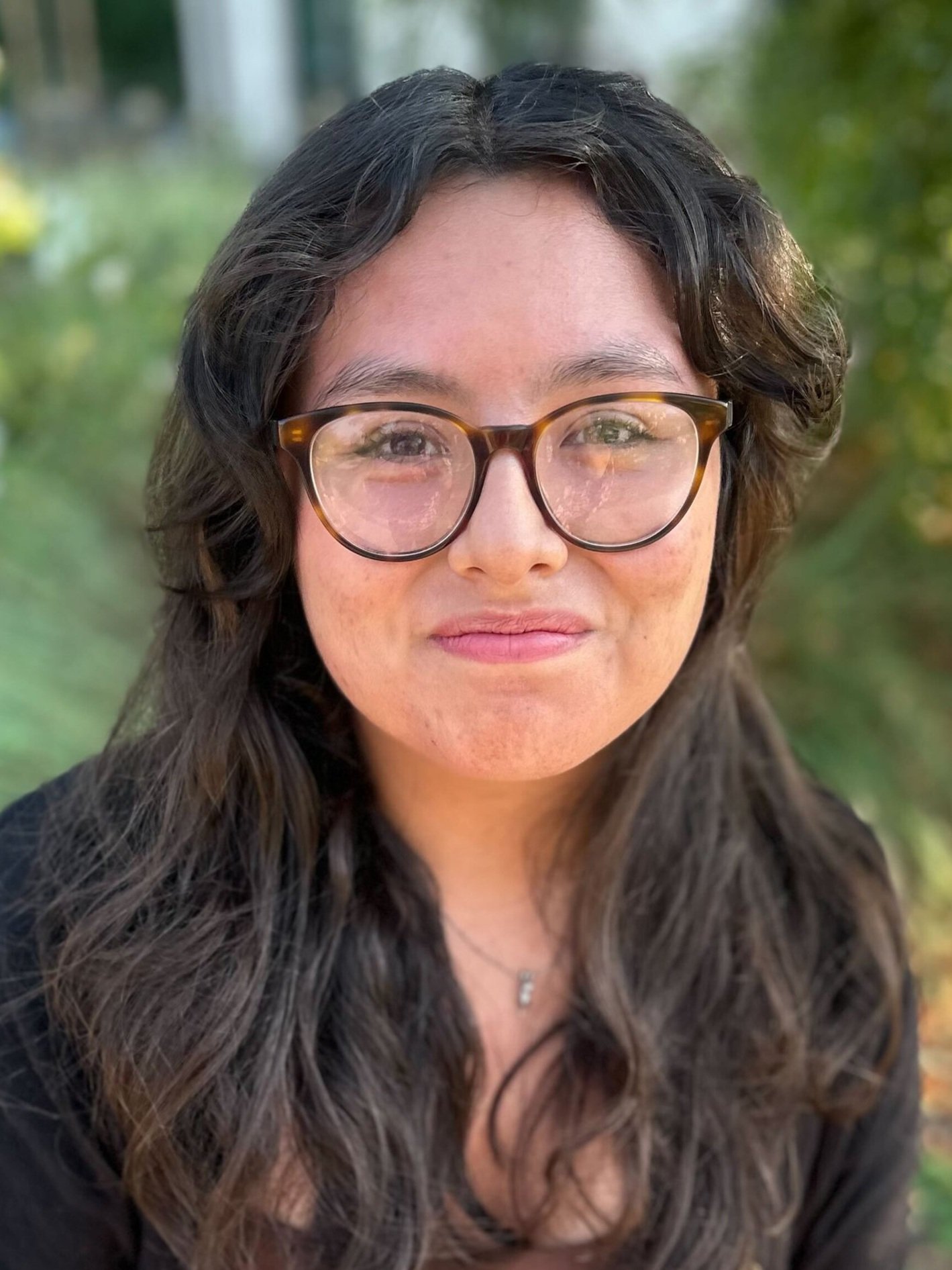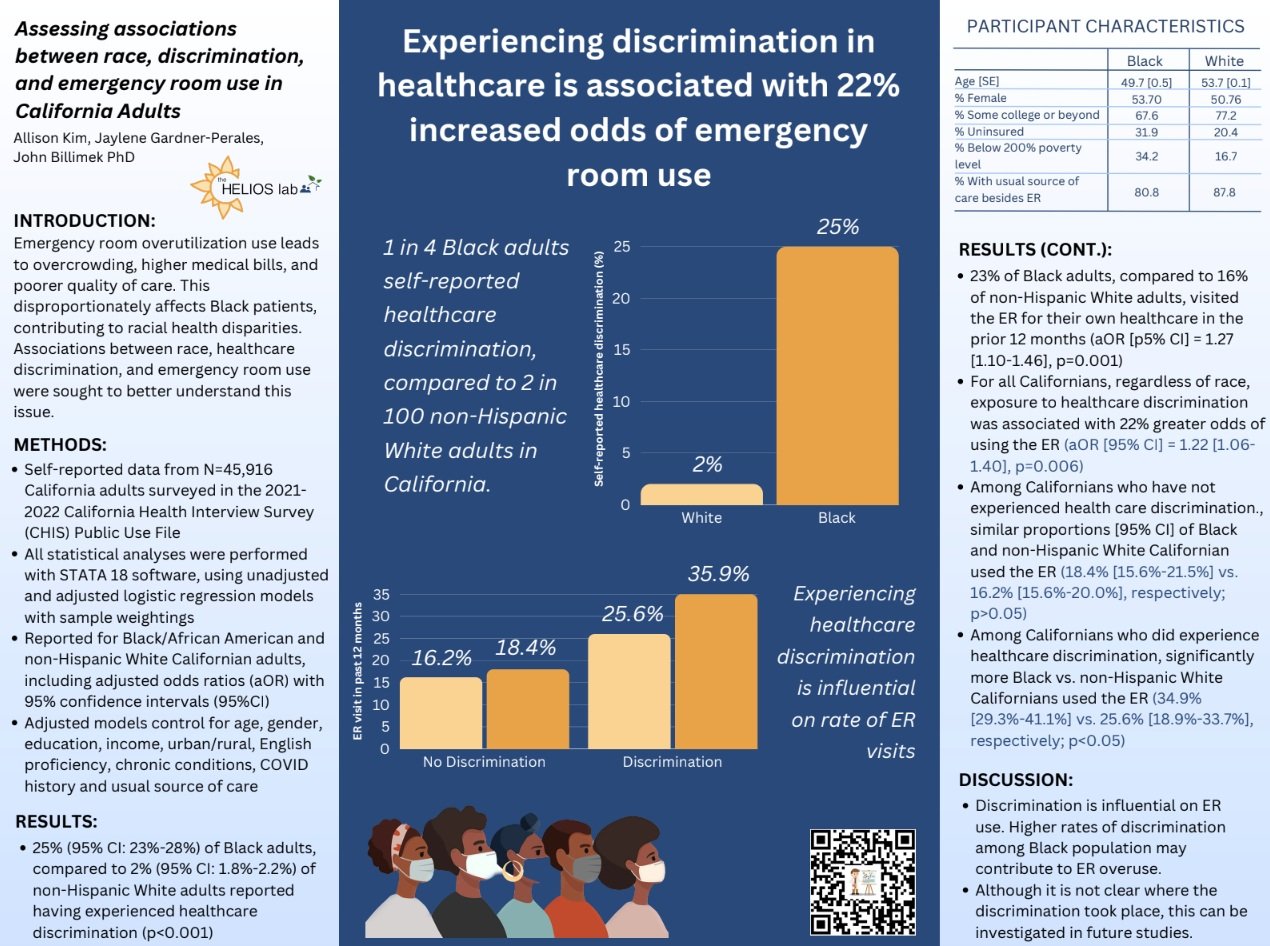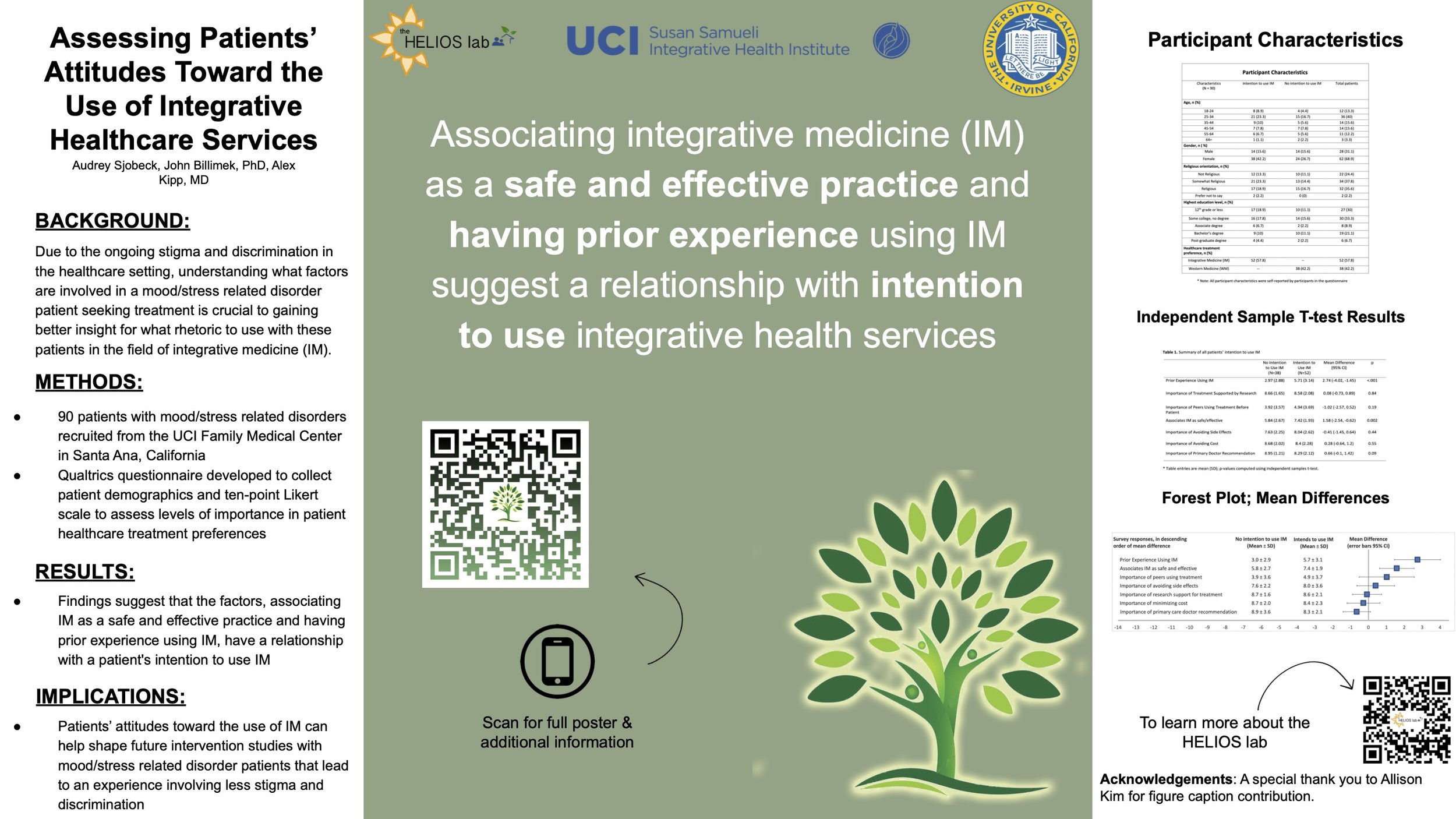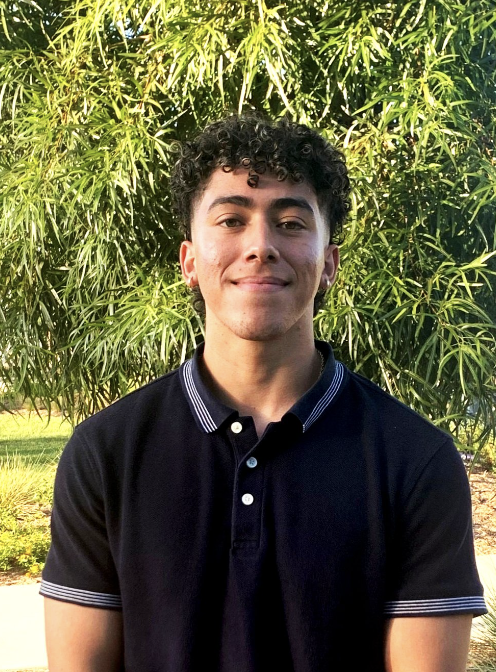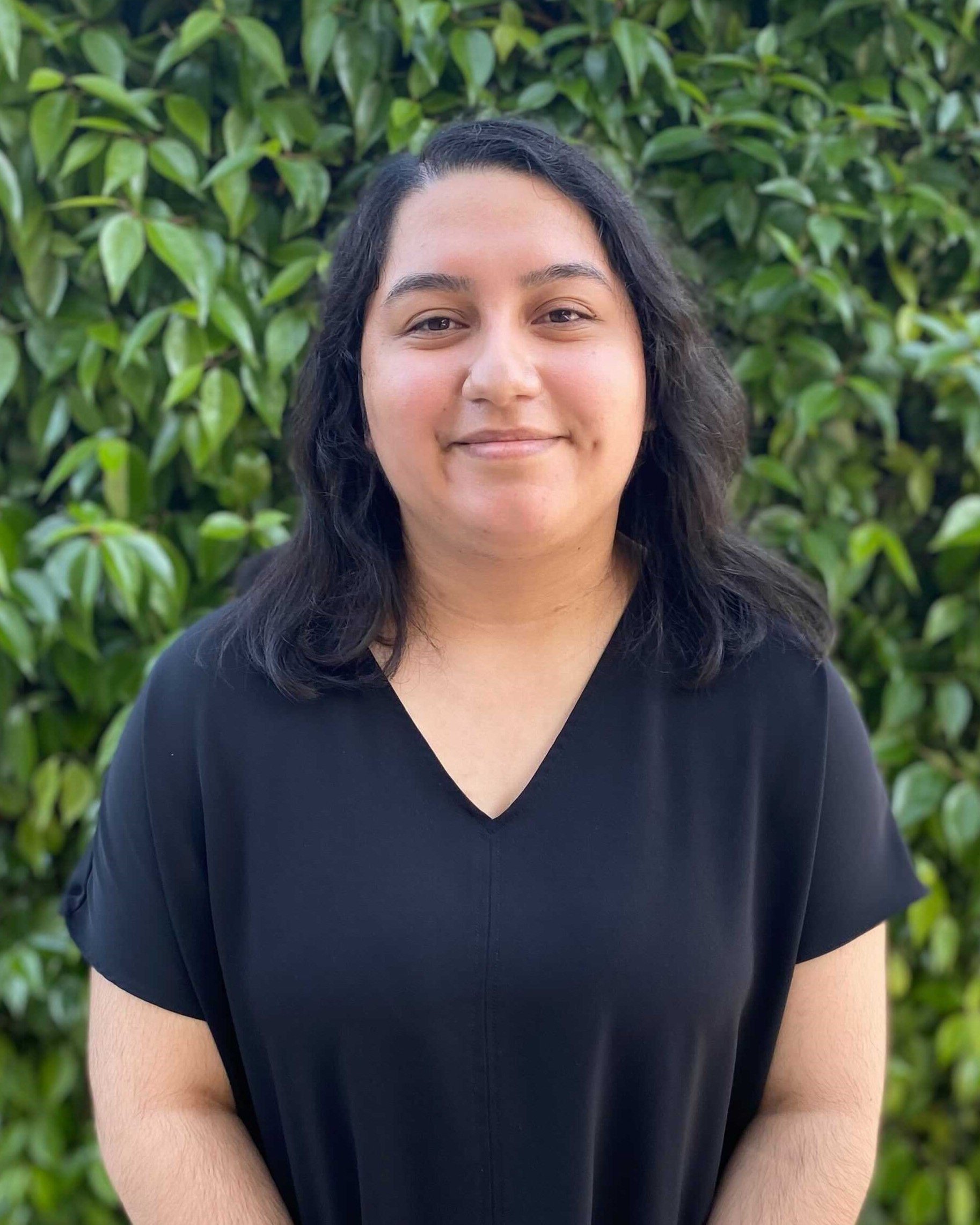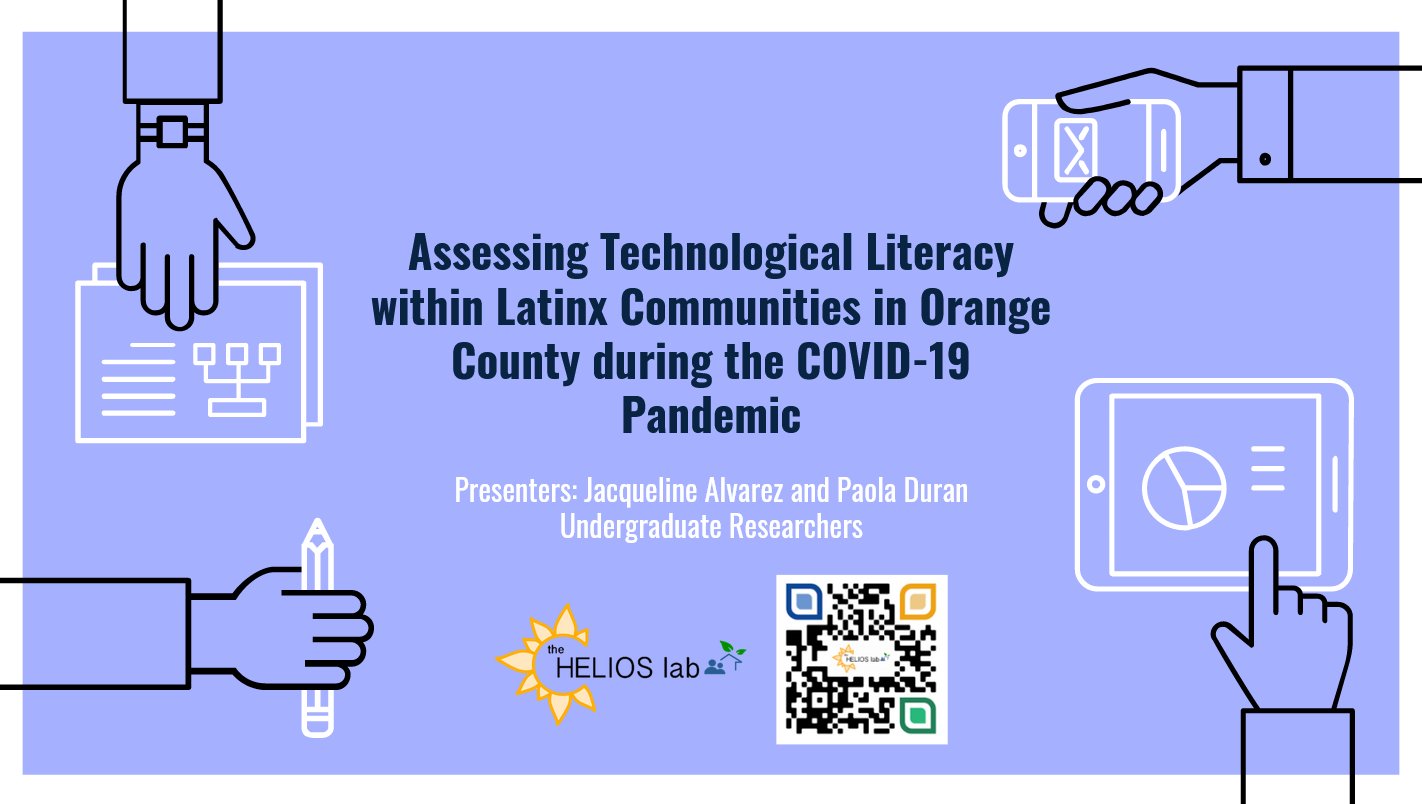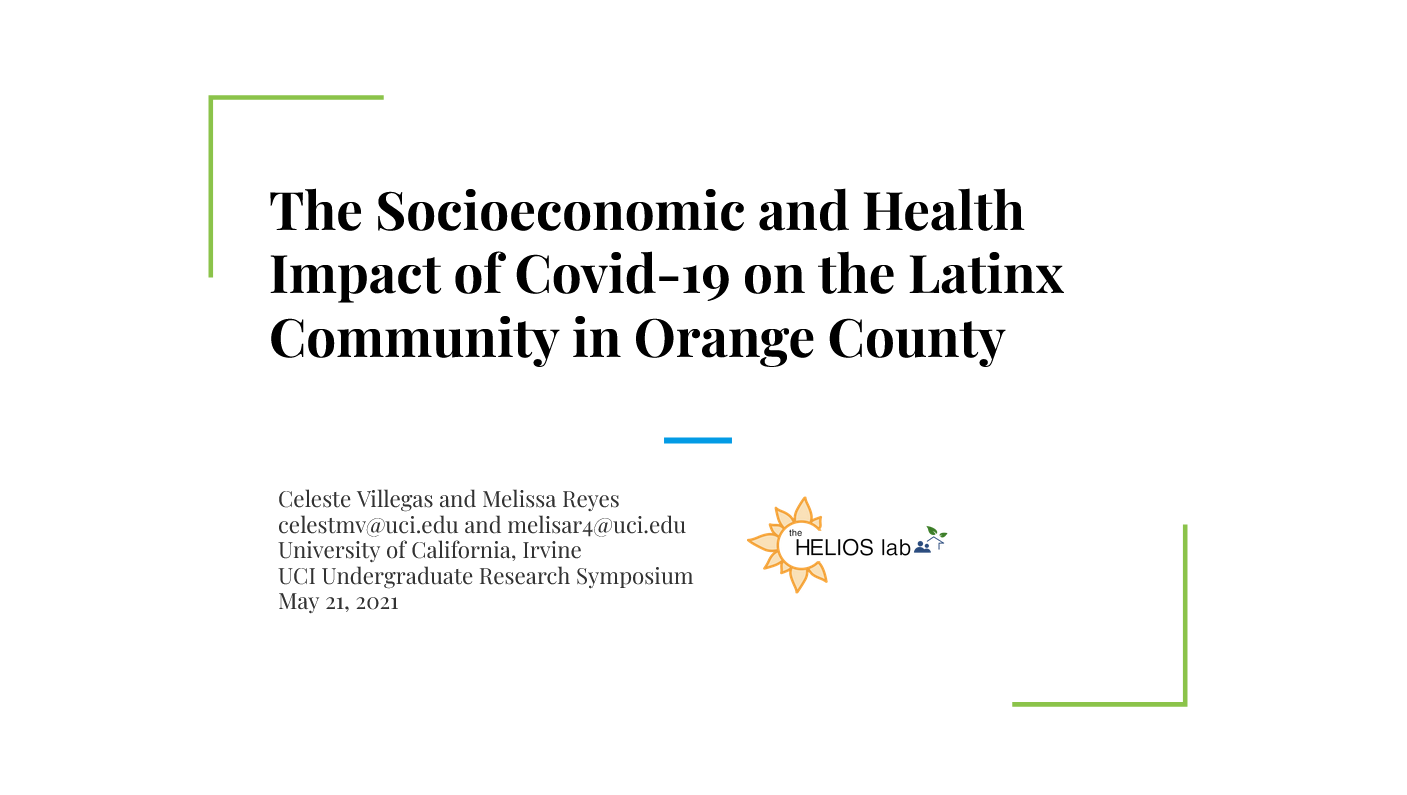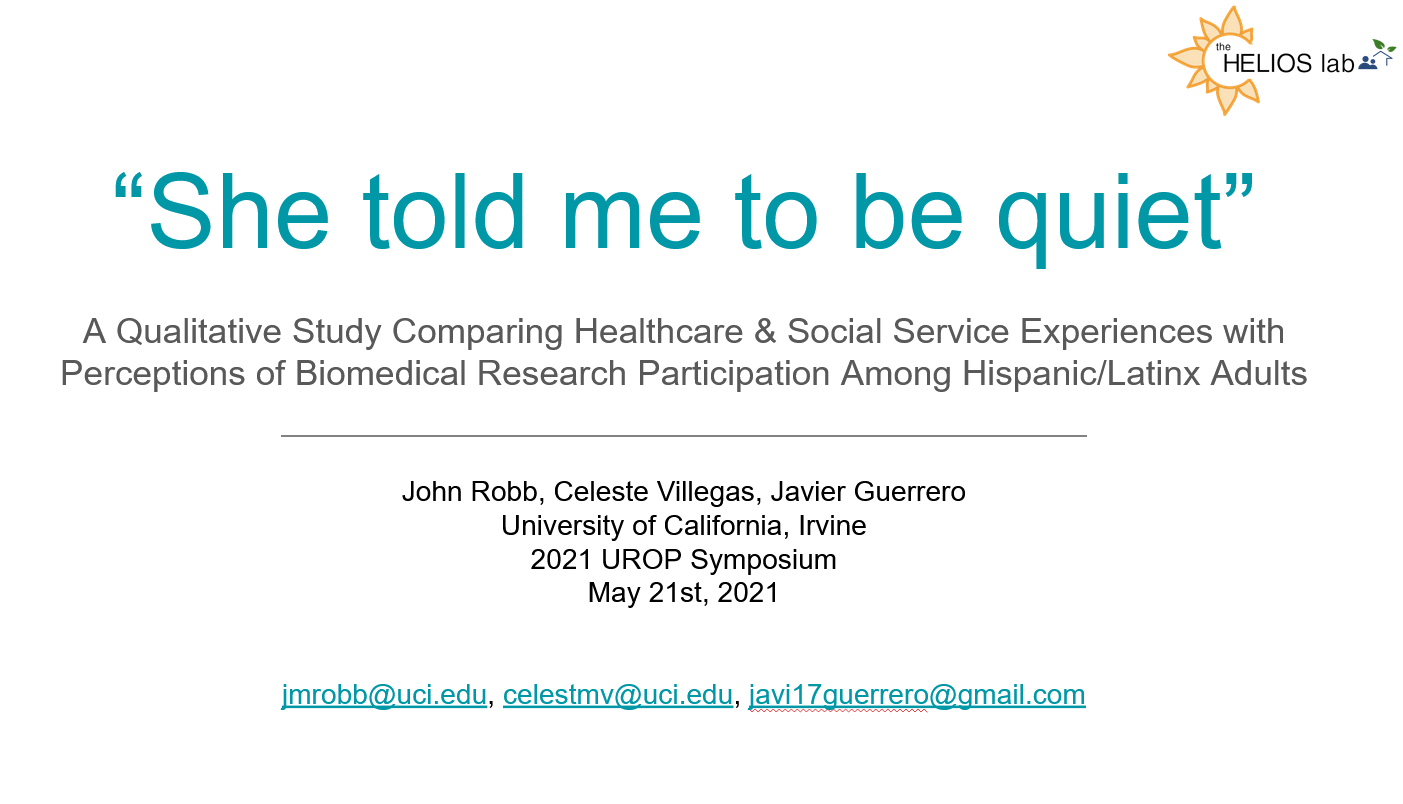Posters & Presentations
2025 Posters and Presentations
Exploring Patient and Provider Perspectives on Insulin Self Titration
Mario Camacho II
(he/him/his)
Biological Sciences
Class of 2025
Justin Urquiza
(he/him/his)
Human Biology
Class of 2026
Amber Huesca
(she/her/hers)
Human Biology
Class of 2026
As Type 2 diabetes cases rise, insulin self-titration becomes increasingly important for managing blood glucose levels. While effective, many patients are reluctant to adopt this titration method due to various barriers. Understanding patients’ perspectives are essential for improving self-management strategies for diabetic patients. This study aims to explore the perspectives of UCI Family Center in Santa Ana patients with uncontrolled diabetes regarding insulin self-titration, identifying key barriers to its implementation. Focus groups were conducted effectively to assess patient experiences in navigating diabetes management and their attitudes towards this titration method. 14 patients participated providing valuable insights into clinical and personal challenges. An inductive thematic analysis was conducted from the focus groups identifying recurring themes in responses. The study’s findings suggest that the patients encounter several challenges in adopting insulin self-titration, including mistrust and uncertainty, fear and apprehension, and knowledge gaps. Additionally, patients expressed preferences for clear, physician-led instructions, and language accessibility to improve comprehension. These results emphasize the complexity of self-titration adoption and highlight the need for educational support. Addressing these barriers may improve patient confidence, promote self-management, and lead to better glycemic control. Future research should focus on developing interventions that enhance provider support, and develop strategies to empower patients to confidently self-titrate insulin.
How Patient-Centered Care Improves Medication Adherence in Latinx Hypertensive Patients
Naomi Jennae Ferrer
(she/her/hers)
Biological Sciences
Class of 2025
Valeria Lopez Duarte
(she/her/hers)
Public Health Policy
Class of 2025
Patient-centered care (PCC) has emerged as a critical approach in addressing health disparities by prioritizing the individual needs, preferences, and cultural backgrounds of patients. This is especially vital in communities where language and systemic barriers often hinder access to quality care. This study examines the impact of Patient-Centered Care (PCC) on medication adherence among Spanish-speaking hypertensive patients in Santa Ana, a population that faces significant healthcare disparities due to language barriers and limited access to culturally competent care. By exploring the connection between PCC and adherence, this study aims to identify strategies for improving treatment outcomes in this underserved community. Survey data from 390 patients at UCI’s clinic assessed PCC through an 11-question survey on patient-doctor relationships and visit experiences. Findings suggest that patients who reported positive interactions with their doctors had higher PCC ratings and better medication adherence, while those who experienced negative visits were less likely to adhere to their prescribed treatment. These results highlight the importance of fostering strong patient-doctor relationships to improve medication adherence and overall health outcomes in Latinx populations.
Exploring the Implication of Food Insecurity on Hypertension Outcomes in Hispanic Patient Population
Sai Tulugu
(he/him/his)
Public Health Sciences
Class of 2025
Laura Renero
(she/her/hers)
Biological Sciences
Class of 2025
Hispanic Americans experience a disproportionate incidence of food insecurity, contributing to higher rates of chronic conditions like hypertension. The Mi Propio Camino (MPC) study evaluated a culturally tailored group medical visit model to improve blood pressure (BP) management and medication adherence in the Latinx community. A total of 650 hypertensive Hispanic patients from UCI FQHCs were retrospectively divided into food secure (FS, n=313) and food insecure (FI, n=355) groups. Participants completed a four-session hypertension management course, with pre- and post-intervention assessments of BP, lifestyle habits, and self-reported medication adherence. At baseline, FI patients had similar BP readings to FS patients but showed lower adherence to medication (t=-1.548, p=0.061) and healthy behaviors (t=4.123, p<0.001). One month after the intervention, BP differences remained nonsignificant (t=0.596, p=0.277), while the FI group showed improved medication adherence (non adherence decreased from 57.26% to 48.23%) and lifestyle behaviors (mean increased from 3.64 to 4.44; t=-0.778, p=0.219). Following MPC, a subset of patients with FI were invited to a focus group to share patient perceptions of experiences of managing FI with high blood pressure. Focus groups with FI patients (n=6) highlighted a strong desire to eat healthy, but persistent social and economic barriers. These findings suggest community-based, culturally sensitive education can support improved hypertension outcomes and address medication hesitancy. Ongoing follow-up and thematic analysis will further explore the impact of food insecurity on patient health behaviors.
MEMS, Pill Counts and Surveys: Predictive Validity of 3 Assessments of Medication Nonadherance
Marissa Ruiz
(she/her/hers)
Public Health Sciences
Class of 2026
Kimberly Rodriguez
(she/her/hers)
Public Health Sciences
Class of 2025
Medication non-adherence is a significant contributor to poor chronic disease outcomes, particularly within the Latinx community. Failing to follow prescribed medication can lead to worsening health conditions, increased complications, and higher rates of hospitalization. Previous research has shown that the Safran Reasons for Non-adherence Scale (SRNS) is a valid predictor of health outcomes for Latinx adults with hypertension.This study compares the validity of two self-reported vs. objective measures of non-adherence to predict successful hypertension management. Spanish-speaking adult patients with hypertension were enrolled and asked to use MEMS caps, which recorded each time the pill bottle was opened over a 30 day period. After 30 days, participants returned for a follow up visit where MEMS caps were collected, blood pressure (BP) was measured and both MMAS and SRNS were administered. Participants were categorized as “Self-reported adherent” or “Self-reported non-adherent” based on survey responses. Objective non-adherence was defined as taking less than 80% of prescribed doses, as determined from MEMS data, and was compared between the self-reported adherent and non-adherent groups using independent sample t-test. BP levels were compared between adherent and non-adherent patients for both measures using independent samples t-tests. The MEMS cap detected fewer non-adherent patients (35%) compared to MMAS (44%) and SRNS (64%), highlighting disagreement across methods. However, only MEMS based adherence was strongly associated with blood pressure outcomes, with non-adherent patients showing significantly higher systolic and diastolic BP (p<0.001). These findings suggest that while self-report tools identify more perceived barriers, objective monitoring provides a more reliable predictor of future blood pressure control.
The Role of Interpreter Services in Supporting Hypertension Self-
Management
Jocelyn Vielma-Garcia
(she/her/hers)
Biological Sciences
Class of 2025
Medication nonadherence remains a pervasive issue in clinical care, leading to adverse health outcomes and increased healthcare costs. While numerous factors contribute to nonadherence, language barriers are often overlooked. As part of the Mi Propio Camino (MPC) study—a broader investigation into barriers to chronic disease management in diverse populations—we hypothesize that patients who need an interpreter but lack consistent access to one are more likely to report low medication adherence. This analysis explores how interpreter availability affects self-reported medication adherence among patients with varying levels of language access. We analyzed baseline data from 666 patients who completed the Morisky Medication Adherence Scale (MMAS) as part of the MPC study. Patients were grouped based on interpreter access: (1) Interpreter Not Needed (n = 232), (2) Interpreter Always Available (n = 249), and (3) Interpreter Not Always Available (n = 185). Nonadherence was coded as a binary outcome (1 = low adherence, 0 = moderate/high adherence). Adherence rates were compared across groups using one-way ANOVA. Significant differences in adherence were found between the three groups (p < 0.001). The proportion of patients reporting low adherence increased with decreased language access: Interpreter Not Needed: 50.0%, Interpreter Always Available: 59.0%, and Interpreter Not Always Available: 74.0%. Language access is a critical determinant of medication adherence. Patients who required but did not consistently receive interpreter support were more likely to report nonadherence. These findings underscore the need for healthcare systems to invest in consistent interpreter services and language-concordant care to promote equity and improve patient outcomes.
Amanda Arevalo
(she/her/hers)
Human Biology
Class of 2026
Understanding the Impact of Health Literacy on Medication Adherence within the Hispanic/Latinx Community
Stacy Segura
(she/her/hers)
Human Biology
Class of 2026
Health Literacy among the Hispanic community is a crucial issue that is often overlooked due to multifaceted factors such as language barriers, economic issues, and food insecurity. Health literacy—a patient’s ability to understand the degree of their overall health and comprehend medical treatment plans— is a major contributing factor impacting medication adherence. This is significant because the depth of understanding one’s diagnosis and treatment contributes in the expansion of better health management and better health outcomes. Medication Adherence continues to be a challenge due to persistent communication gaps and limited knowledge exchange between patients and providers. The purpose of this research is to access how 391 Spanish-speaking Hispanic/Latinx patients at the UC Irvine’s Federally Qualified Health Center (FQHC) understand their diagnoses and how this understanding affects their adherence to prescribed medications. This was evaluated through three major health literacy measures; did the provider check the patient’s understanding, was the patient satisfied with interpersonal care, and was the patient involved in decisions regarding their medication. Additionally, the findings concluded that 67% of patients whose provider checked their understanding had low adherence (p=0.363), 71% of patients who did not have a provider with strong interpersonal care had low adherence (p=0.02), 72.2% of patients whose provider did not involve them in decision-making had low adherence (p=0.03). The hypothesized results suggest that patients with higher health literacy and stronger communication with the provider demonstrate higher levels of medication adherence in additional to better lifestyle changes. These results underscore the importance of addressing health literacy and provider-patient barriers. Utilizing this data can inform strategies to improve health outcomes by strengthening patient engagement, education, and culturally competent care within the Hispanic/Latinx communities.
Understanding how tradeoffs and beliefs impact medication adherence among Hispanic patients at UCI FQHCs
Angyelisa Hernandez
(she/her/hers)
Public Health Sciences
Class of 2026
Imagine choosing between buying groceries for your family and refilling a prescription for your high blood pressure. For many low-income Hispanic patients, this is not just hypothetical, it is a daily reality. My study examines how life tradeoffs such as financial constraints, conflicting obligations, and beliefs about medication overuse influence medication adherence among Hispanic patients receiving care at UCI’s Federally Qualified Health Centers (FQHCs). While prior studies focused on general barriers to medication adherence, like language, cost, or access, few have closely examined the specific tradeoffs patients are actively making. Patients at UCI FQHCs were surveyed on financial tradeoffs and medication adherence. Patients who answered “often” or “sometimes” had to cut back on other expenses and were grouped as Yes Tradeoffs. Patients who answered “never” were grouped as No Tradeoffs. We compared adherence scores and analyzed beliefs about medications using four subscales: General Overuse, General Harms, Specific Necessity, and Specific Concerns. Among the 668 patients surveyed, those who reported making financial tradeoffs, such as cutting back on basic needs to afford medications, had significantly lower medication adherence rates than those who did not. 74% of patients in the Yes Tradeoffs group (N=122) reported non-adherence, while 57% of those in the No Tradeoffs group (N=546) reported adherence. Patients who experienced tradeoffs also held more negative beliefs about medications. These findings highlight the need for healthcare providers to engage in more empathetic and personalized conversations with patients to address economic realities and medication concerns to improve health outcomes.
2024 Posters & Presentations
Effects of Interpreter Access on the Quality of Care Spanish-Speaking Patients with Hypertension Experience
Claire Ali-Khan
(she/her/hers)
Pharmaceutical Sciences
Class of 2024
Justin Covarrubias
(he/him/his)
Biological Sciences
Class of 2024
Experiencing language barriers in accessing healthcare is a prevalent issue within the Hispanic community, often resulting in limited access to healthcare services and disparities in treatment and outcomes. With Spanish being the second most spoken language in the US and a high prevalence of hypertension among Hispanic adults in the US (64.5%), addressing this issue is critical. This study aims to investigate the impact of interpreter availability on the quality of patient-centered care (PCC) and interpersonal processes of care (IPC) for Spanish-speaking hypertensive patients. PCC was assessed through an 11-question survey focusing on patient-doctor relationships, while IPC was evaluated based on consistent interpersonal care, provider communication, and patient involvement in decision-making. Survey data was collected from 390 Spanish-speaking hypertensive patients at UCI’s clinic in Santa Ana and categorized into three groups based on interpreter accessibility (interpreter not needed, interpreter always available when needed, and interpreter not always available when needed). Results indicate that inadequate interpreter access significantly diminishes the quality of care received by patients. Understanding the influence of interpreter availability on patient care is crucial for improving healthcare delivery, particularly for Spanish-speaking hypertensive patients. Ultimately, to enhance the overall quality of care provided to hypertensive Spanish-speaking patients improving health outcomes within this population.
Exploring the Implications of Food Insecurity on Hypertension Outcomes in Hispanic Patient Population in Santa Ana, CA
Saivishnu Tulugu
(he/him/his)
Public Health Sciences
Class of 2025
Horacio Mendoza
(he/him/his)
Human Biology
Class of 2024
Hispanic Americans face disproportionate challenges with food insecurity, leading to elevated rates of chronic conditions such as hypertension. The Mi Propio Camino (MPC) study uses a group medical visit model to assess the efficacy of culturally tailored blood pressure (BP) management classes in improving medication adherence and hypertension prognosis within the Latinx community. The study recruited 650 hypertensive Hispanic patients from UCI FQHCs, dividing them retrospectively into food secure (FS) (n=313) and food insecure (FI) (n=355) groups. Participants underwent a four-session hypertension management course. Pre- and post-intervention assessments included BP measurements, adherence to healthy lifestyle choices, and self-reported medication adherence. At baseline, FI patients exhibited comparable systolic and diastolic BP values (t=-.292, p=0.385, and t=-.807, p=0.210, respectively) to FS patients but demonstrated lower medication adherence (t=-1.548, p=0.061) and healthy behaviors adherence (t=4.123, p<0.001). One month following classes, BP values showed no significant difference between the FI vs. FS groups (t=0.596, p=.277), while medication nonadherence decreased (from 57.26% nonadherent to 48.23% nonadherent) and healthy behaviors (x = 3.64, s=1.26 to x = 4.44, s=1.11) improved in the FI group (t=-0.778, p=0.219). These findings suggest that community-based classes may positively influence blood pressure management and decrease culturally reinforced medication hesitancy. We hope to monitor patients’ progress over time and conduct a focus group to understand the nuances of food insecurity in patients’ lives.
Evaluating the Effectiveness of the HELIOS Lab in Providing Support and Improving Confidence for First-Generation Students at UC Irvine
Aracely Blanco
(she/her/hers)
Public Health Sciences
Class of 2024
Many undergraduate students join research labs to gain experience in their desired field of study. Although studies have described the general benefits of undergraduate research, more information is needed to determine how labs affect student confidence in fulfilling their desired careers. This study focuses on the HELIOS Lab at UCI, which aims to create a more equitable healthcare system by training the next generation of healthcare professionals. The goal of this study is to conduct an internal review of the HELIOS Lab, examine how the lab supports students, and determine whether participation in the lab leads to higher student confidence in their career goals. HELIOS students were given an intake, quarterly, and exit survey where they answered questions about themselves, their confidence level, and support from UCI faculty on a scale of 1 to 5, with 1 indicating not confident/supported at all and 5 indicating extremely confident/supported. Of the 38 students, 82% identified as first-generation and 68% as Hispanic/Latinx. Overall, students felt more supported by faculty within the HELIOS Lab compared to outside faculty. Additionally, students had a higher average confidence level in the exit form compared to the intake form (4.18 + 0.84 versus 3.56 + 0.81, respectively). These results provide preliminary information suggesting that the HELIOS lab has features that improve student confidence. More work is needed to determine which research lab practices are useful for students. This information will allow other UCI labs to prioritize useful tools to help their students.
Cardiorenal Syndrome and Its Effect on the Latinx Community
Naomi Ferrer
(she/her/hers)
Biological Sciences
Class of 2025
Stacy Segura
(she/her/hers)
Biological Sciences
Class of 2026
Andrea Serrano
(she/her/hers)
Psychological Sciences
Class of 2024
Mario Camacho
(he/him/his)
Biological Sciences
Class of 2025
Amanda Arevalo
(she/her/hers)
Biological Sciences
Class of 2026
Cardiorenal syndrome (CRS) encompasses a range of pathophysiological conditions affecting the heart and kidneys, where dysfunction in one organ can lead to dysfunction in the other, either acutely or chronically. The prevalence of CRS is on the rise globally, attributed to the increasing incidence of acute and chronic cardiovascular diseases (CVD), resulting in elevated rates of hospitalization, symptom severity, mortality, and healthcare expenditures. Despite the disproportionate impact of CVD on marginalized communities, the influence of disparities on CRS remains understudied within diverse populations. The purpose of this research is to investigate how health disparities impact the overall experience and management of Cardiorenal Syndrome (CRS) within the Latino community. The problem we are trying to solve in this research project is to understand and address the health disparities prevalent in the Latino community, particularly CRS. By examining how these disparities affect the overall experience and management of CRS among Latinos, including their access to healthcare, treatment efficacy, and overall quality of life, we aim to identify areas for intervention and improvement in healthcare delivery and outcomes for this population.
On the Brink: The Importance of Emergency Savings on Maintaining Healthy Behaviors
Angyelisa Hernandez
(she/her/they)
Chemistry
Class of 2026
Michelle Torrico
(she/her/hers)
Public Health
Class of 2024
The Hispanic population faces a higher risk of suffering from food insecurity, primarily stemming from financial constraints that hinder consistent access to nutritious meals. Research has shown that when a family’s income decreases, they are most likely to shift to buying cheaper food choices, but few studies investigate the additional impact of emergency savings on the ability of patients to follow dietary recommendations. Our study examined the impact of food insecurity status and emergency savings on adherence to dietary recommendations in Hispanic patients with hypertension (N = 663) from UC Irvine’s Family Qualified Health Centers. Patients completed a questionnaire where they answered questions related to their food insecurity status, emergency savings, and the number of days they ate breakfast/fruits or vegetables. Patients were categorized into 3 groups, those who were food secure with emergency savings, food secure with no emergency savings, and food insecure (regardless of whether or not they had emergency savings). We found that patients who were food secure with emergency savings reported eating breakfast more days (M = 6.4) compared to those who were food secure with no savings (M = 5.8) and those who were food insecure (M = 5.6). Our results suggest that emergency savings are important when considering adherence to dietary recommendations for those who are food insecure and food secure. Therefore, addressing food deserts, increasing funding for food assistance programs, and creating community partnerships are crucial for increasing food security in low-income communities where emergency savings are scarce.
Assessing associations between race, discrimination, and emergency room use in California Adults
Allison Kim
(she/her/hers)
Biological Sciences
Class of 2024
Jaylene Gardner Perales
(she/her/hers)
Biological Sciences
Class of 2026
Emergency room (ER) overutilization leads to overcrowding, higher medical bills, and poorer quality of care. Because Black patients have a higher prevalence of utilizing the ER for avoidable cases, this contributes to racial health disparities. To better understand this pattern, this study sought associations between race, healthcare discrimination, and ERuse. Self-reported data was collected from over 45,000 California adults surveyed in the 2021-2022 California Health Interview Survey (CHIS) Public Use File. Then, the data was analyzed with STATA 18 software, using unadjusted and adjusted logistic regression models with sample weighting. Adjusted models were controlled for covariates including age, gender, chronic conditions, history of COVID-19, and having a usual source of care other than the ER. It was found that Black adults had significantly higher odds of being discriminated against compared to non-Hispanic White adults (25% vs. 2%, p<0.0001), as well as slightly higher rates of visiting the ER (23% vs. 16%, p=0.001). When controlling the responses for covariates, it was found that regardless of race, Californians had a 22% greater odds of using the ER if they had experienced healthcare discrimination (p=0.0006). When comparing Black and non-Hispanic White Californians who had not experienced healthcare discrimination, ER use was similar among both populations, although this finding was not statistically significant (18.4% vs. 16.2%, p>0.05). However, when Black and non-Hispanic White Californians who had experienced healthcare discrimination, Black Californians had higher odds of using the ER (34.9% vs. 25.6%, p<0.05). These findings reveal the strong association that healthcare discrimination has with ER use. Additionally, they reveal the higher odds that Black Californians have of experiencing healthcare discrimination than non-Hispanic White Californians. These results may explain, in part, the racial health disparity Black patients face in the context of ER use. However, with this being a cross-sectional study, it is unknown whether or not discrimination occurred in a primary care office or within the ER itself. This may be the basis of future studies.
Analyzing The Barriers to Cervical Cancer Screening
Justin Urquiza
(he/him/his)
Biological Sciences
Class of 2026
Natalie Aguilar
(she/her/hers)
Psychology
Class of 2025
Marissa Ruiz
(she/her/hers)
Public Health Science
Class of 2026
This research aims to investigate the primary concerns hindering regular Pap smear screenings among women from underserved communities and lower socioeconomic backgrounds to address the issues with physician-centered care and patient-centered teachings. The study seeks to identify the predominant fears preventing patients from undergoing regular pap smear screenings, especially those near the Orange County area as opposed to other studies which survey broader regions or other countries. The questionnaire surveys were given by students in person to patients who had not scheduled a pap smear by the guideline-recommended date. Surveys involved questions regarding patient's experiences, stigmas, and socioeconomic background in relation to their cervical health.
Audrey Sjobeck
(she/her/hers)
Psychology
Class of 2023
Relevant literature demonstrates that stigma and discrimination in the healthcare industry from language often leads to apprehensive attitudes toward receiving proper treatment for patients’ conditions, limiting the treatment options patients have. Understanding what factors are involved in a patient seeking treatment is crucial to gaining better insight for what rhetoric to use with these patients in the field of integrative medicine (IM). In a pilot study involving 90 patients with mood/stress related disorders from the UCI Family Medical Center in Santa Ana, California, patients’ attitudes toward IM services were assessed. Taking approximately five minutes per questionnaire, a background assessment was used to collect patient demographics such as age, gender, education level, religious orientation, and preference for integrative or western medicine. Immediately following was a ten-point Likert scale survey that prompted the patient to rank various levels of importance in healthcare treatment preferences such as cost of care, symptom management, friend/family experiences, and reputability of the care itself. The pilot study was interpreted through an analysis of variance using an independent sample t-test. Findings suggest that factors such as associating IM as a safe and effective practice and having prior experience using IM, have a relationship with a patient's intention to use IM. The factors associated with patients’ attitudes toward the use of IM can help shape future intervention studies of interpreting which types of language used with mood/stress related disorder patients lead to an experience that involves less stigma and discrimination.
A Pilot Study of Diabetes Education Videos to Reduce Knowledge Gaps in Patients from an FQHC
The UCI Family Health Center in Santa Ana serves predominantly low-income Latinx Spanish-speaking patients, many of whom have type 2 diabetes mellitus. Physicians have limited time to assess the patient’s diabetes, their overall level of knowledge of the disease and important gaps in that knowledge. To help establish a baseline of basic diabetes knowledge, we worked with a family medicine physician to develop a two-minute educational video about diabetes–how it affects the body and how to treat it–available in English and Spanish. Two versions were created in each language—one with visuals (graphics that complement the video content) and one without visuals (only the physician talking). In this pilot study, 38 patients were randomized to view one of the two versions in their preferred language. Patients then filled out a survey where they rated their understanding of the video content and to assess their diabetes knowledge. Although this study’s small sample size did not have statistical power to detect significant differences, descriptive analysis comparing understanding and knowledge between the patients in the two video versions showed the overall level of understanding was high and knowledge was moderate. Knowledge scores were higher in participants with visuals (79.2% [SD]) versus those without visuals (72.2% [SD]), suggesting a hypothesis that visuals increase knowledge gain is worth exploring further. The main finding is that health education videos can be well-received and understandable to patients, with or without visuals. Research in this domain is important for proper patient education and improved health outcomes.
Naomi Ferrer
(she/her/hers)
Biological Sciences
Class of 2025
William Hernandez
(he/him/his)
Psychological Science
Class of 2024
Jeffrey Garcia
(he/him/his)
Biological Sciences
Class of 2023
Gabriela Lopez Ruano
(she/her/hers)
UCI SOM Postbacc
Class of 2023
Angyelisa Hernandez
(she/her/hers)
Chemistry
Class of 2026
Effects of Health-Related Social Control on Medication Adherence in Latinx Patients with Hypertension
Sidra Ali
(she/her/hers)
Public Health Sciences
Class of 2023
Latinx adults are more likely to have untreated hypertension (HTN) than any other race-ethnic group nationally. Medication adherence proves to be a key variable for HTN management and research is examining influences from one’s social network. An understudied social influence is health-related social control (HRSC), which focuses on interpersonal interactions that specifically entail influence and regulation. HRSC control has two main subtypes: pressure or persuasion. As such, this study aims to investigate the effects of HRSC on medication adherence in Latinx adults diagnosed with hypertension. Data was collected through a baseline questionnaire from the Mi Propio Camino study. Medication adherence was measured using Morisky Medication Adherence Scale and HRSC was assessed with ten questions regarding behaviors expressed by loved ones on a 6 point Likert scale. We ran a binary logistic regression between medication adherence and HRSC components and used participant ratings at 25th and 75th quartile to see how changes in the level of pressure and persuasion may impact medication non-adherence. We found that participants with higher levels of persuasion were more likely to be non-adherent than those reporting lower levels (p= 0.04), while pressure did not have a statistically significant relationship (p= 0.96). Additionally, 75% of participants with both low and high levels of pressure were non-adherent. Comparatively, 83% of individuals with reports of high persuasion were non-adherent, while 67% of those with reports of low persuasion were non-adherent. To better understand this relationship, we will conduct focus groups with participants to hear their direct experience.
Sleep Quality as a Protective Factor for Latinx Hypertensive Patients Facing Financial Stress
2023 Posters & Presentations
Medication Hesitancy and Blood Pressure Medication Adherence Among Latinx Adults with Hypertension
Claire Ali-Khan
(she/her/hers)
Pharmaceutical Sciences
Class of 2024
Assessing Patients’ Attitudes Toward the Use of Integrative Health Services
Melanie Lopez
(she/her/hers)
Public Health Science & Public Health Policy
Class of 2022
Non-adherence to medication is very common among the Latinx population and often has detrimental impacts on patients’ lives, and may be related to the mistrust of medication and healthcare professionals. The purpose of this project is to examine the connection of patient-reported hesitancy to an objective measure of adherence to blood pressure medication among Latinx Adults with hypertension. Medication hesitancy was collected using the Beliefs About Medicines Questionnaire (BMQ), which was scored to categorize patients into high vs. low hesitancy groups. Patients were then asked to use a digital pill-bottle cap monitor (MEMS caps) to estimate adherence by recording time stamps for everytime the bottle is opened for a 30 day monitoring period. Nonadherence was defined as taking less than 80% of the prescribed doses over 30 days, and was compared between high hesitancy and low hesitancy groups of patients using Fisher’s exact test. In total, 44 patients (average ± SD age = 56 ± 9 years, 73% female, 98% born outside the US) completed the protocol, with 15 (34%) categorized as high hesitancy and 29 (66%) as low hesitancy. 67% of high hesitancy versus 45% low hesitancy patients exhibited nonadherence in their MEMS cap data (p=0.20). Although not statistically significant, the magnitude of the difference is large and warrants further investigation in a larger sample to determine the association of medication hesitancy with subsequent nonadherence in this population.
William Hernandez
(he/him/his)
Psychological Science, Social Ecology
Class of 2024
Andrea Serrano
(she/her/hers)
Psychological Sciences, Chicano Latino Studies
Class of 2024
Latinos are the largest minority group in the U.S. with the leading cause of death being cardiovascular disease (CVD). Previous research has shown that stress and sleep contribute to hypertension, a risk factor for CVD. However, the interplay between sleep quality and stress has not been investigated extensively as a risk factor for hypertension among Latinos. Financial stress has been associated with a higher risk for myocardial infarction and worse self-rated health. Within the study, we see if sleep quality is a protective factor against exposure to financial stress. Latino adults (n=208) were recruited from a federally qualified health center. Self-reported sleep quality in the past 7 days and current financial stress were assessed. Systolic (SBP) and diastolic (DBP) blood pressure were measured. We hypothesized that there would be a relation between financial stress and blood pressure, which would be moderated by sleep quality. We found a significant difference in sleep quality (t = 6.3, p <.001) between those with high versus low financial stress but not a difference in SBP or DBP (p > 05). We found a significant interaction between financial stress and sleep quality on DBP (F = 4.54, p = .03), wherein patients with high financial stress and low sleep quality had worse DBP (M = 86.59, SD = 13.34) than those with high financial stress and high sleep quality (M = 79.31, SD = 8.56). Our results reveal that among Latino patients, sleep quality may be protective for Latinx hypertensive patients facing financial stress.
Claire Ali-Khan
(she/her/hers)
Biological Sciences
Class of 2024
Aracely Blanco
(she/her/hers)
Public Health Sciences
Class of 2024
Communication Narratives on Cervical Cancer Prevention Among Latina Mothers with Daughters
Esmeralda Garcia-Castellanos
(she/her/hers)
Biological Sciences
Class of 2023
Brianna Flores
(she/they)
Biological Sciences
Class of 2023
Latinas are 40% more likely to be diagnosed with, and 30% more likely to die from cervical cancer compared to non-Latina whites. Previous research has found family support informs whether young adult Latina women obtain HPV vaccination, an effective form of cervical cancer prevention. We examined the perspective of Spanish-speaking Latina mothers about their communication on cervical cancer prevention with their daughters. A total of 12 semi-structured interviews were conducted with Latina mothers who were mostly recruited from a larger NIH-funded project, Mi Propio Camino. Questions included topics on health knowledge, their relationships with their daughters, and mothers’ level of involvement in their daughter’s health decisions. Data were analyzed with the qualitative software program Dedoose, using both deductive and inductive coding. Participants were between 45-64 years old, and 75% of them had health insurance. We found that most participants have had Pap smears in the past, did not know about the HPV test, and only a few were aware of the HPV vaccine. Themes included: limited knowledge of cervical cancer, mothers believing it's their responsibility to inform daughters about cervical cancer prevention, feelings of shame from their Pap smear experiences, lack of access to care due to limited resources and lack of insurance, and positive mother-daughter relationships. A unique finding included some mothers' interest in daughters spreading health information to their peers. It is suggested to explore the communication among Latina siblings or peers, as an effective avenue to spread information on cervical cancer and its prevention.
Michelle Beltran Najera
(she/her/hers)
Public Health Sciences
Class of 2023
Changing Minds or Following Interests? Predictors of behavior change in Latinx hypertension patients in the Mi Propio Camino study.
Managing a chronic health condition like hypertension requires adopting self management behaviors like taking medications and following a healthy lifestyle. Health education interventions focus on encouraging participants to adopt these behaviors with mixed success. The present study examines the degree to which the adoption of new self management behaviors observed in a health education intervention can be attributed to the interests that participants already held prior to the start of the intervention versus developing new interests during the intervention. We are analyzing data from the Mi Propio Camino hypertension education study, in which 205 Spanish-speaking Latinx patients have completed a 4-session series of weekly group education classes. Prior to the classes, participants completed validated questionnaires assessing level of interest in and prior adoption of six different hypertension self management behaviors (medication taking, healthy eating, physical activity, nutritional supplements, stress management and sleep hygiene). Then in the classes, strategies to increase all of these behaviors were presented, and participants were invited to choose which behaviors they wished to adopt. Adoption of each behavior was assessed again throughout the four week course using a daily diary, and after the final session using the same questionnaire from baseline. Our team is currently analyzing (1) the percentage of patients that adopted each behavior, and (2) the correlation between baseline interest in a specific behavior and the likelihood of adopting that behavior. These findings will add to the evidence on the merits of following participants’ prior interests versus introducing new strategies when designing health education interventions for Latinx hypertension patients.
Daniela Garcia
(she/her/hers)
Biological Sciences
Class of 2023
Nydia Gomez
(she/her/hers)
Public Health Sciences
Class of 2023
Allison Kim
(she/her/hers)
Biological Sciences
Class of 2024
Angelique Nguyen
(she/her/hers)
Biological Sciences
Class of 2023
2022 Posters & Presentations
Food Insecurity and Time to COVID-19 Vaccination
Latines in the U.S. have a greater risk of developing type 2 diabetes, and once diagnosed, have worse outcomes compared to other groups, often attributed to limited health literacy. To determine if diabetes health literacy is related to diabetes self-management, primarily Spanish-speaking patients (N=52) averaging 55-64 years of age were assessed through the Spoken Knowledge in Low Literacy in diabetes scale (SKILLD), a 10-item scale evaluating diabetes knowledge in patients at the UCI FQHC. SKILLD Scores were compared between patients with blood sugar (measured as hemoglobin A1c) “above target” vs. “at target” of 8.0% using an independent samples t-test. Above target patients had a mean SKILLD score of 6.2, compared to at target patients with a mean score of 5.2 (p= 0.212). Knowledge on most of the 10 items was similar between the two groups, with the exception of knowledge about symptoms of high blood sugar (answered correctly by 77 % of above target vs. 40% of at target patients; p= 0.009). This outcome might be due to increased intervention of patients with more severe diabetes. Although the sample size was limited, there is no evidence for an association between lower knowledge and poorer diabetes control. In fact, patients with higher A1cs may have as much or more knowledge as patients with lower A1c. Future studies should consider the benefits of addressing knowledge gaps alongside other factors to drive successful diabetes management, and should include larger samples with more comprehensive assessment of potential confounding variables.
Sorina Long
(she/they)
Public Health Science
Class of 2022
COVID-19 has disproportionately impacted vulnerable populations. It is crucial to understand vaccination barriers to guide policies that address socioeconomic factors that impede vaccination uptake. Food insecurity, or the inability to meet nutritional needs, has been shown to affect access to some preventive services. Therefore, we examined the correlation between food insecurity and COVID-19 vaccination uptake. We retrospectively studied Spanish-speaking hypertensive adult patients (n = 285) in a federally qualified health center in Orange County, comparing the vaccination times of both food insecure and non-food insecure groups.We collected data from electronic health records and used survival analysis (Kaplan-Meier test) to analyze the correlation between food insecurity and time to COVID-19 vaccination. Participants mean (SD) age was 58 ± 10 and 67.6% were women. Median time for vaccination with the first dose was 106 days for both food insecure and non-food insecure participants. For the second dose median time was 28 days for the non-food insecure group while the food insecure group was 29 days. For the booster, median time for food insecure participants was 270 days and 282 days for non-food insecure participants. Time to first dose, second dose, and booster shot were similar between food insecure and food insecure patients (all p’s>0.05), indicating no significant difference between groups. The lack of influence food insecurity has on vaccination timing is a significant finding, indicating the need to allocate resources to other socioeconomic factors that have a greater impact on vaccination uptake and by extension implementing more effective policies.
Kayla Miles
(she/her)
Public Health Science
Class of 2022
Examining the Correlation of A1C Levels with Knowledge in Diabetes in Spanish Speaking FQHC Patients
Esmeralda Garcia-Castellanos
(she/her/ella)
Biological Science
Class of 2023
Validating the Safran Reasons for Adherence Scale Among Latinx Adults with Hypertension
Melissa Reyes
(she/her/hers)
Biological Science
Class of 2022
Shary Castro Alvarez
(she/her/hers)
Psychological Science
Class of 2023
Mirleth de los Santos
(she/her/hers)
Biological Science
Class of 2022
Medication nonadherence contributes to disparities in chronic disease outcomes among Latinx communities. Prior research shows that the Safran Reasons for Nonadherence Scale (SRNS) is a valid predictor of health outcomes for Latinx adults with diabetes. We examined the validity of expanding the use of the SRNS to predict successful hypertension management. Spanish-speaking adult hypertension patients were invited to monitor their medication adherence using a pill bottle cap monitor (MEMS cap) that recorded every time the bottle was opened for a 30 day period. After 30 days, MEMS caps were collected, blood pressure (BP) was measured and the SRNS was collected for each patient. Participants were categorized as “Self-reported adherent” or “Self-reported nonadherent” based on SRNS responses. Objective nonadherence was defined from MEMS data as <80% of prescribed doses taken, and was compared between the self-reported adherent versus nonadherent groups using Fisher’s exact test. BP was compared between adherent versus nonadherent patients for both measures with independent samples t-tests. Of the 44 participants completing the study, self-reported adherent (N=15) versus nonadherent (N=29) patients did not differ in objective nonadherence rates (53% vs. 52%, respectively; p=0.99). BP did not differ between self-reported adherence groups, but systolic BP was significantly higher among objective nonadherent vs. adherent patients (150±19mmHg vs. 128±12mmHg; p<0.001). Although the sample size is limited, there is no strong evidence that the SRNS is a valid predictor of objective nonadherence or BP, but objective nonadherence measured by MEMS caps is highly predictive of BP.
Assessing Pre-Post Changes to Intervention Session in Knowledge, Attitudes, Behaviors, and Blood Pressure Within Hypertensive Latinx Patients from the UCI Family Health Center in Santa Ana
Paola Duran
(she/her/hers)
Biological Science
Class of 2022
Spanish-speaking, Latinx adults with hypertension are disproportionately affected by poor blood pressure control linked to lower uptake of recommended management strategies and less access to culturally and linguistically appropriate services. Group health education classes offered in Spanish and focused on peer support and individualized goal setting may help improve management behaviors and outcomes. In a longitudinal, observational study, we examined changes in knowledge, attitudes, behaviors, and blood pressure among Spanish-speaking Latinx hypertensive patients from the UCI Family Health Center in Santa Ana participating in four weekly classes. A total of 44 females and 16 males averaging 56 years of age participated. Surveys and blood pressure measurements were collected pre and post-intervention, with pre to post changes examined with paired t-tests for continuous variables and McNemar’s test for categorical variables. Knowledge scores did not change significantly, but attitudes towards blood pressure management improved, with the proportion of patients reporting negative beliefs about medications dropping from 71.1% to 40.0% (p=0.003). There were modest increases in health behaviors, including an increase in patients engaging in breathing exercises to reduce stress from 50% to 82% (p=0.022). Marginal blood pressure changes were observed for average (±SD) systolic (pre: 142 ± 17mmHg vs. post: 138 ± 14mmHg; p=0.065) and diastolic (pre: 85 ± 10mmHg, post: 83± 9mmHg; p=0.103) readings. These findings suggest that group health education classes offered in Spanish can promote positive attitudes about behavior change even if knowledge ratings do not change significantly.
¿Cómo Voy a Llegar a la Clínica?: Hypertensive Latinx Patients’ Journey to a Federally Qualified Health Center in Santa Ana, CA
Liliana Chau
(she/her/hers)
Chemistry (Chemical Biology)
Class of 2022
Danielle Zaragoza
(she/her/hers)
Biological Science
Class of 2022
Brianna Flores
(she/they)
Biological Science
Class of 2023
Patients' ability to attend appointments is vital for managing their chronic illness and overall preventing more serious health outcomes. Transportation may act as a barrier to healthcare access within the Latinx community, especially patients who lack control over their transportation. Latinx patients with hypertension who see healthcare providers at an FQHC in Santa Ana completed a questionnaire as a part of an NIH-funded study. A multivariable adjusted model indicated that distance was not statistically significant (p-value = 0.61) in not attending hypertension health classes. However, this study highlights and validates a patient’s journey to receiving care, as transportation is oftentimes overlooked when a patient attends their visit. Of the patients that completed the questionnaire (n=284), there were 90 males and 192 females, with a mean age of 58.2 (± 9.98). For patients that relied on another person to drop them off (n=25), 12% were male and 88% were female. For patients that rely on transportation (n=17), 11.8% had an income above $20,000 and 70.5% had an income below $20,000. This suggests that gender and income influence how much autonomy patients have with their transportation, which may act as a barrier for healthcare access within the Latinx community. However, this data is limited to Orange County and is not representative of the whole Latinx community. Therefore, data should be collected beyond Santa Ana to better understand how transportation could act as a barrier for the Latinx community in managing chronic illness(es).
Examining Attendance Predictors for Hypertensive Intervention Sessions
Joseline Magana
(she/her/hers)
Public Health Science
Class of 2023
Jacqueline Del Carmen Alvarez
(she/her/hers)
Public Health Science
Class of 2022
Marginalized groups in the United States encounter barriers that prevent their access to healthcare. The aim of this study is to better understand what influences patients’ motives to attend in-person health education classes. Participants were recruited for the Mi Propio Camino (MPC) study and completed a baseline questionnaire that collects data on their demographics, beliefs about medications, food insecurity, readiness to change, and attitudes between patient and provider interactions. Data on patient attendance for at least one MPC class was collected using RedCap. Upon bivariate analyses, there were a total of 284 participants with an average age of 58.24 (± 9.98) and composed of 60% of female participants. The only significant variable associated with class attendance was patients’ readiness to change (RTC). The RTC data collected considered changes in multiple healthy lifestyle strategies, and for every 1 point increase in RTC score, participants were twice as likely to attend an MPC class. Notably, age (p-value= 0.013), distance (p-value=0.61) to the intervention site, and food insecurity (p-value=0.14) were not significant predictors of class attendance. These findings suggest that readiness to change plays a significant role when participants are deciding whether to attend educational classes. Research can be done to further understand ways to increase patient attendance, for instance, participants' perception of RTC values.
Assessment of the Correlation of Medication Beliefs with Time to COVID-19 Vaccination
Shifa Haquani
(she/her/hers)
Biological Science
Class of 2022
Nancy Dang
(she/her/hers)
Human Biology & Anthropology
Class of 2022
Since the COVID-19 vaccine’s public release, there has been a drop in cases, signifying its importance in protecting our communities. Prior research indicates correlation between medication avoidance and influenza vaccine hesitancy. Therefore, we aim to explore disparities in vaccination by investigating the relationship between medication beliefs and the time to receiving COVID-19 vaccinations, to evaluate for a similar trend. In this study, responses from the Beliefs about Medication Questionnaire (BMQ) and medical records of 283 Spanish-speaking hypertensive adult patients (mean (SD) age = 58 (10)) at UCI FQHC in Santa Ana, CA were collected prior to 06/01/2021, when COVID-19 vaccines became widely available. Unadjusted survival analysis via the Kaplan-Meier test evaluated patient beliefs of the necessity and potential harms of medication to determine any differences in vaccination status between those with positive (necessity>concerns), neutral (concerns=necessity) or negative (concerns>necessity) medication beliefs. Median time to first dose, full vaccination and booster from administration of previous dose were 106, 28 and 243 days, respectively. In comparing time to event with medication beliefs, there was a marginal association between the three groups of medication beliefs and their time to the first dose (median time = 98, 106, and 115 for positive, neutral and negative groups, respectively; p=0.073), second dose (p=0.92), and booster dose (p=0.65). These findings show that medication beliefs alone may not differentiate time to COVID vaccination. Further research can analyze different measures of medication beliefs and co-variables in order to address health disparities.
Tatum Cravens
(she/her/hers)
Public Health Science
Class of 2022
2021 Posters & Presentations
2019 Posters & Presentations
Examining the Impact of Medication Beliefs on Medication Adherence Among Uncontrolled Hypertensive Patients
Justin Cha, Jacqueline Macias-Sandoval, Elizabeth Ordoñez, Michael Xu, Alexis Pellecer, Alejandra Villagomez, Helena Stevenson, Erick Deloera, Mimi Lam, Cristabel Nunez, Alexandra Garcia, Abhiruchi Chaulagain
Investigating the Lack of Minority Representation from the Latino/Hispanic Community in Biomedical Research through the Analysis of Community Seminars to Encourage Involvement
Melissa Ramirez, Jennifer Bui, John Robb, Raquel Hidalgo, Jessica Arizmendi De La Torre, Aeryus Holloway
Adriana Orellana-Barrientos, Anne Osuji, Araiye Medlock, Sheila Panez, Jocelyn Almanza, Adan Rodriguez, Chau Nguyen, Kenneth Robertson-Brown, Tiffany Calero, Eric Gonzalez, Melissa Ramirez, Maria Andres-Acevedo, Michelle Agustin, Sandra Lopez, Elizabeth Ordonez, Raquel Hidalgo, Peony Yu
Current biomedical research lacks minority participation specifically from the Hispanic/Latino community. By one estimate, only 1% of Latinos participate in clinical trials. The All of Us Research Program funded by the NIH seeks to create a diverse and inclusive medical data set from one million or more participants in the United States to advance precision medicine, and aims to include communities that are underrepresented in biomedical research like the Hispanic/Latino community. In this study, we are conducting focus groups to understand why Hispanics/Latinos are hesitant to participate in biomedical research. We anticipate that mistrust among healthcare providers and investigators, as well as limited formal education among participants, may be barriers negatively impacting participation in biomedical research. Currently, one focus group has been conducted. 12 Spanish speaking participants, with an average age of 57.6 + 10.7 ranging from 38 to 72 years, were recruited from a health care clinic in Santa Ana, California. A brief overview of the All of Us study was provided and the participants were asked questions regarding the benefits, risks, and requirements of biomedical research participation. Preliminary qualitative analysis of transcripts from the focus group suggest themes of mistrust, fear of manipulation, concerns about the personal benefits of participating, and lack of knowledge about the research protocol were identified. Additional focus groups will be conducted to triangulate the findings. The preliminary results suggest that barriers to participation may be better understood and addressed through community engagement processes focused on engendering trust.










